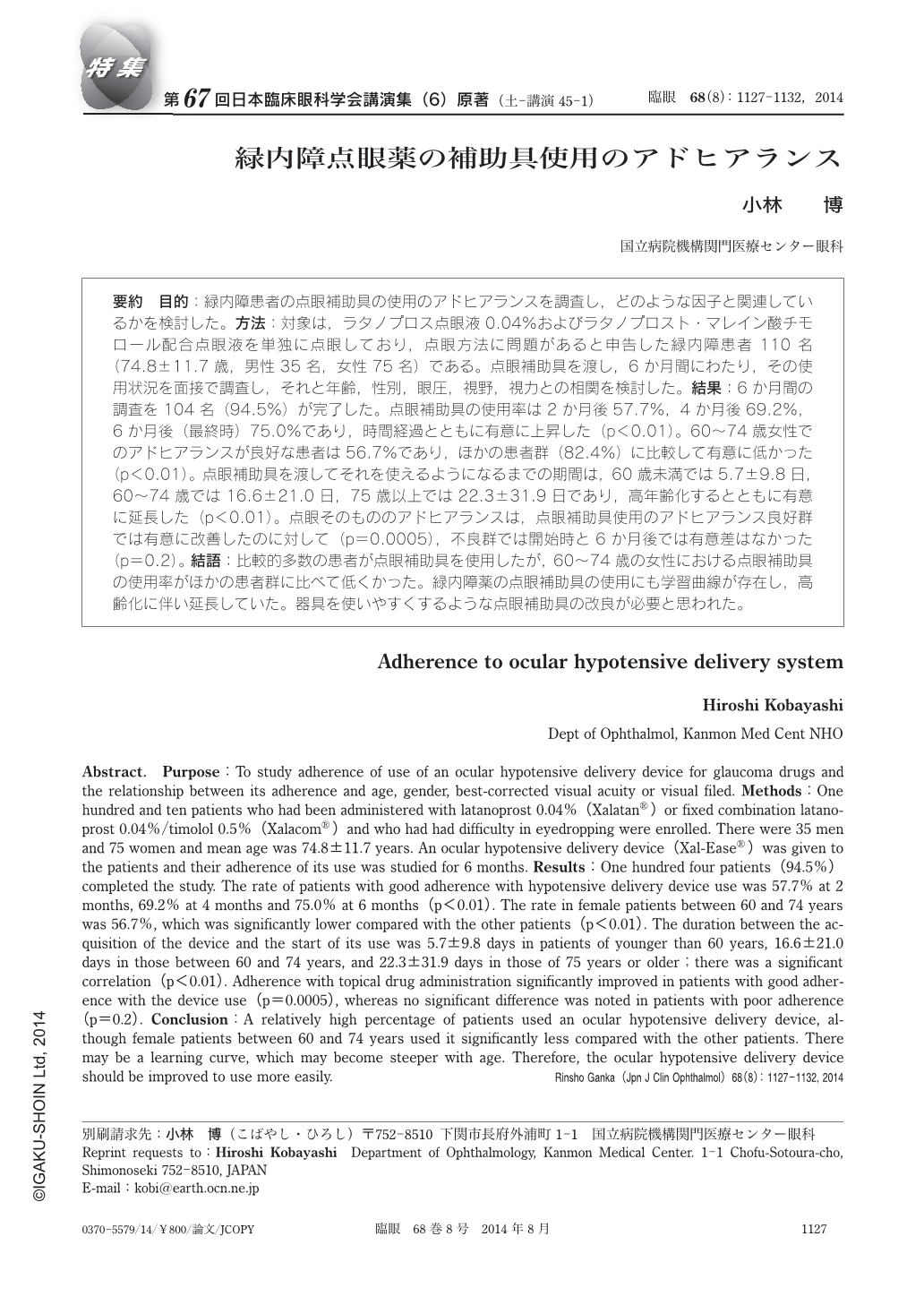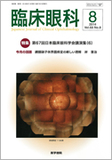Japanese
English
- 有料閲覧
- Abstract 文献概要
- 1ページ目 Look Inside
- 参考文献 Reference
要約 目的:緑内障患者の点眼補助具の使用のアドヒアランスを調査し,どのような因子と関連しているかを検討した。方法:対象は,ラタノプロス点眼液0.04%およびラタノプロスト・マレイン酸チモロール配合点眼液を単独に点眼しており,点眼方法に問題があると申告した緑内障患者110名(74.8±11.7歳,男性35名,女性75名)である。点眼補助具を渡し,6か月間にわたり,その使用状況を面接で調査し,それと年齢,性別,眼圧,視野,視力との相関を検討した。結果:6か月間の調査を104名(94.5%)が完了した。点眼補助具の使用率は2か月後57.7%,4か月後69.2%,6か月後(最終時)75.0%であり,時間経過とともに有意に上昇した(p<0.01)。60~74歳女性でのアドヒアランスが良好な患者は56.7%であり,ほかの患者群(82.4%)に比較して有意に低かった(p<0.01)。点眼補助具を渡してそれを使えるようになるまでの期間は,60歳未満では5.7±9.8日,60~74歳では16.6±21.0日,75歳以上では22.3±31.9日であり,高年齢化するとともに有意に延長した(p<0.01)。点眼そのもののアドヒアランスは,点眼補助具使用のアドヒアランス良好群では有意に改善したのに対して(p=0.0005),不良群では開始時と6か月後では有意差はなかった(p=0.2)。結語:比較的多数の患者が点眼補助具を使用したが,60~74歳の女性における点眼補助具の使用率がほかの患者群に比べて低くかった。緑内障薬の点眼補助具の使用にも学習曲線が存在し,高齢化に伴い延長していた。器具を使いやすくするような点眼補助具の改良が必要と思われた。
Abstract. Purpose:To study adherence of use of an ocular hypotensive delivery device for glaucoma drugs and the relationship between its adherence and age, gender, best-corrected visual acuity or visual filed. Methods:One hundred and ten patients who had been administered with latanoprost 0.04%(Xalatan®)or fixed combination latanoprost 0.04%/timolol 0.5%(Xalacom®)and who had had difficulty in eyedropping were enrolled. There were 35 men and 75 women and mean age was 74.8±11.7 years. An ocular hypotensive delivery device(Xal-Ease®)was given to the patients and their adherence of its use was studied for 6 months. Results:One hundred four patients(94.5%)completed the study. The rate of patients with good adherence with hypotensive delivery device use was 57.7% at 2 months, 69.2% at 4 months and 75.0% at 6 months(p<0.01). The rate in female patients between 60 and 74 years was 56.7%, which was significantly lower compared with the other patients(p<0.01). The duration between the acquisition of the device and the start of its use was 5.7±9.8 days in patients of younger than 60 years, 16.6±21.0 days in those between 60 and 74 years, and 22.3±31.9 days in those of 75 years or older;there was a significant correlation(p<0.01). Adherence with topical drug administration significantly improved in patients with good adherence with the device use(p=0.0005), whereas no significant difference was noted in patients with poor adherence(p=0.2). Conclusion:A relatively high percentage of patients used an ocular hypotensive delivery device, although female patients between 60 and 74 years used it significantly less compared with the other patients. There may be a learning curve, which may become steeper with age. Therefore, the ocular hypotensive delivery device should be improved to use more easily.

Copyright © 2014, Igaku-Shoin Ltd. All rights reserved.


